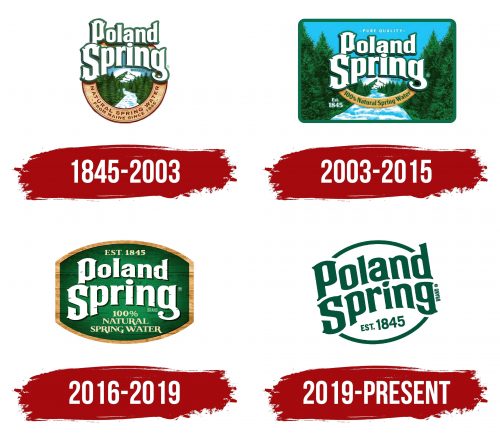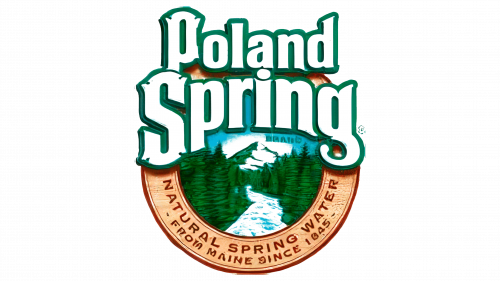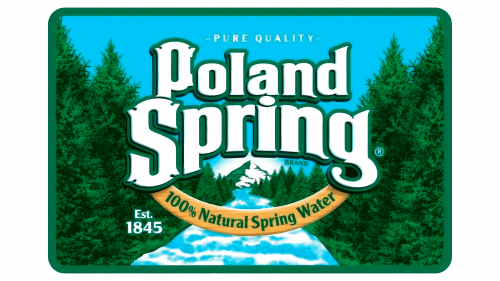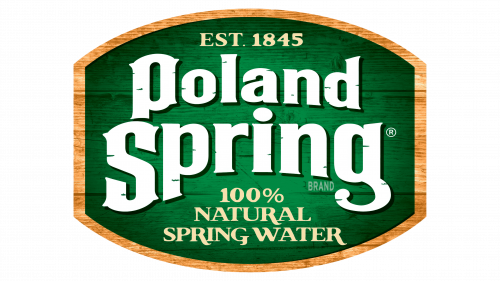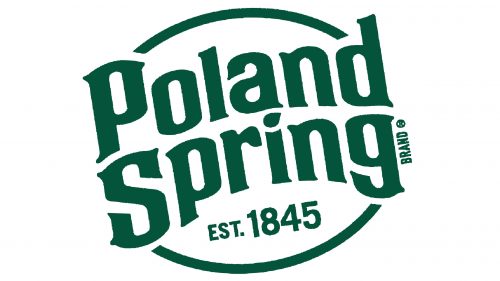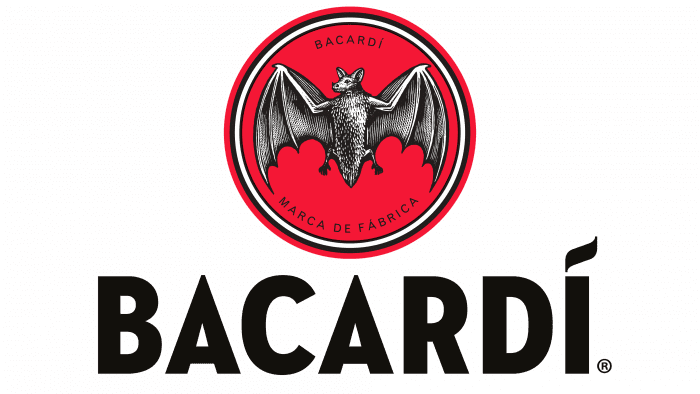The Poland Spring logo is not just a beautiful depiction of natural riches in symbols. The identity focuses on contemporary issues and offers the right solutions. The producer positions the purchase of quality bottled water as an inexhaustible source of health. The company has always focused on the quality of its products and continues to uphold its commitments to consumers.
According to the brand, drinking clean, ecological water means taking care of your health today to avoid a range of diseases in the future. Responsible recycling practices demonstrate care for the planet’s future.
The motifs of the modern logo accurately reflect traditions: the founding date, the brand name, and the environmentally friendly green color scheme. The identity has no excesses, and none are needed. Just three elements clearly and thoroughly convey the essence and content.
Poland Spring: Brand overview
Poland Spring’s history began when Hiram Ricker bought a property on a hill in Poland, Maine 1845. Ricker had originally intended to farm the area, but he soon learned that his land had a naturally occurring spring that produced the purest water.
Ricker began bottling and selling modest amounts of this spring’s water in 1859. Travelers and locals who stopped at Ricker’s farm were the initial patrons. People started coming from far and wide to test the water as it swiftly established a reputation for having therapeutic qualities.
Ricker constructed a modest hotel adjacent to the spring in 1860 and called it the “Poland Spring House.” Rich city people would frequent the hotel to take in the pure air and spring water, making it a popular getaway.
The business experienced substantial expansion during the 1870s. The water quality and purity won the town a gold medal during the 1876 Philadelphia Centennial Exposition. As a result of this notoriety, the demand for this water and the brand’s popularity expanded dramatically.
The enterprise started bottling water in glass bottles in 1883 to sell outside the hotel. This ground-breaking choice opened up new markets and increased the number of people who could purchase the water.
The brand’s fame peaked in the late 19th and early 20th centuries. The best hotels and dining establishments in New York and other big cities received the water. A bottling factory was constructed in 1907, greatly boosting output capacity.
Its appeal grew during the 1920s thanks in large part to Prohibition, which many perceived as a healthier substitute for alcoholic beverages.
The 1960s and 1970s were a time of transition for the business. In 1969, it was purchased by Perrier Group of America, creating additional avenues for distribution and manufacturing growth.
In the 1980s, the brand started bottling water in plastic bottles, giving customers more access and convenience. This choice increased the brand’s market presence and greatly increased sales.
An important turning point in the business’s history was reached in 1992 when Nestlé acquired the Perrier Group, and the company joined Nestlé Waters North America. This acquisition allows the brand to access Nestlé’s global resources, beverage production, and marketing expertise.
Flavored waters and sports drinks were among the new products added to its lineup in the 2000s. Additionally, the business invested in updating its manufacturing facilities and making its packaging more environmentally friendly.
Poland Spring Preserve, an eco-friendly park with 6000 acres surrounding Poland, Maine’s original spring, opened for business in 2007. This effort demonstrated the company’s dedication to preserving the environment and natural resources.
In the 2010s, the enterprise encountered several legal and environmental issues regarding the use of water resources and marketing claims. The business made a concerted effort to enhance its business openness and environmental standards.
The company made a big announcement in 2018 about using only recycled plastic bottles for its whole product line by 2022. This choice fits with a larger plan to lessen the environmental impact.
In 2019, the producer responded to consumer demand for more environmentally friendly packaging by launching their first premium water brand in aluminum cans. This program was a component of a larger plan to cut back on the use of plastic.
In 2020, considerable progress was made toward utilizing only recycled plastic. The firm started manufacturing bottles of recycled plastic for some product forms ahead of schedule.
Poland Spring Origin, a premium water from deep natural springs in Maine, was added to the company’s product portfolio in 2021. This product was aimed at people looking for premium water with unusual provenance.
Significant corporate structure changes occurred in 2021 when One Rock Capital Partners and Metropoulos & Co. purchased Nestlé’s North American water division, including Poland Spring. As a result, a brand-new, independent business called BlueTriton Brands was established, and it currently oversees the Poland Spring brand.
Under BlueTriton Brands’ direction, the firm launched its sustainability programs in 2022. The business improved its initiatives to safeguard Maine’s spring ecosystems and water resources.
A new marketing campaign highlighting the water’s natural sources and relationship to Maine’s environment was introduced in 2023.
Additionally, the enterprise increased its online presence by starting fresh web projects and customer loyalty schemes. This includes using social media to increase customer involvement and expanding online direct-to-consumer sales.
Meaning and History
What is Poland Spring?
It is a brand of bottled water produced by BlueTriton Brands. The water is extracted from natural springs in Maine. Known for its crisp and refreshing taste, the brand offers a variety of bottled water, including still and sparkling, in a variety of sizes to meet different needs. It uses recyclable packaging and participates in water conservation activities. The brand is widely available in supermarkets, stores and online retailers, making it a popular choice for those looking for high quality natural spring water.
1845 – 2003
The first logo of the brand clearly and effectively announced itself. The colorful depiction of mountains emphasized the product’s eco-friendliness. Pure water from Maine has always been perceived as a source of strength, health, and energy due to its quality, characteristics, and composition. The natural landscape featuring the region’s mountains created a proper and logical perception of the symbol. The realistic color palette evoked a desire to visit the mountains and try the refreshing water. At first glance, the mountains appear as the background, but they are the logo’s informational foundation and central element.
The logo’s three-dimensional lettering served an informative function. The font was clear, and the letters were elegant, arranged in two rows along a curved axis. They had precise outlines and a green border, while the letters were white. There was harmony between the words, the illustration, and the informational block at the bottom.
The circle played a key role, focusing attention on each element. The mountain river symbolized purity and movement, adding dynamism to the logo.
2003 – 2015
In the new period, the logo’s geometry changed, incorporating the shape of a square. Elements familiar to consumers remain, but they have undergone several transformations, maintaining a high visual perception of the logo.
A green frame outline highlights the main elements. The focus of those choosing bottled water is drawn to the center of the logo. There, a mountain river is realistically depicted, symbolizing the flow of life. The gentle blue color of the water is associated with purity, emphasizing quality. The percentage on the logo highlights the water’s superiority over any other.
The brand name is written in large font, with a white shade giving it a presentable look. In this identity, numerical values enhance the brand’s authority in the eyes of the target audience.
The trees on the logo can be discussed at length. They are part of a beautiful scene and indicate the company’s environmental responsibility. Nestlé has repeatedly participated in actions aimed at nature protection, reflected in the logo design.
2016 – 2019
2016, the logo was simplified: all visual and multifaceted effects, such as rivers, sky, and trees, were removed. Information clutter was minimized. The new identity reflects the concise text, a minimal color palette, and the essence alone.
The brand’s founding date is displayed at the top of the logo. The phrase “Poland Spring” occupies the central position. At the bottom, a phrase informs consumers that they are holding environmentally clean and tasty water.
To retain attention, designers used a rectangular geometric frame. It is done in a natural beige color, associated with a tree trunk, though figuratively, without any detailing.
2019 – today
2019, the simplest logo in terms of graphic shapes and text additions was created. It is minimalist and conveys the company’s authority. Many already trust the manufacturer and know the high quality of its products, so detailed information is not required. Clarity, understandability, and simplicity come to the forefront.
The brand name Poland Spring is presented in dynamic graphics. The large font is arranged in a semicircle, with the text centered within the circle for quick brand recognition. The founding date is at the bottom, testifying to stability, confidence, and reliability. Mentioning quality was deemed unnecessary by the designers, as this information is already well-known.
The green color scheme continually reminds us of nature and eco-friendliness. The logo demonstrates an impressive balance of dynamism and harmony.

